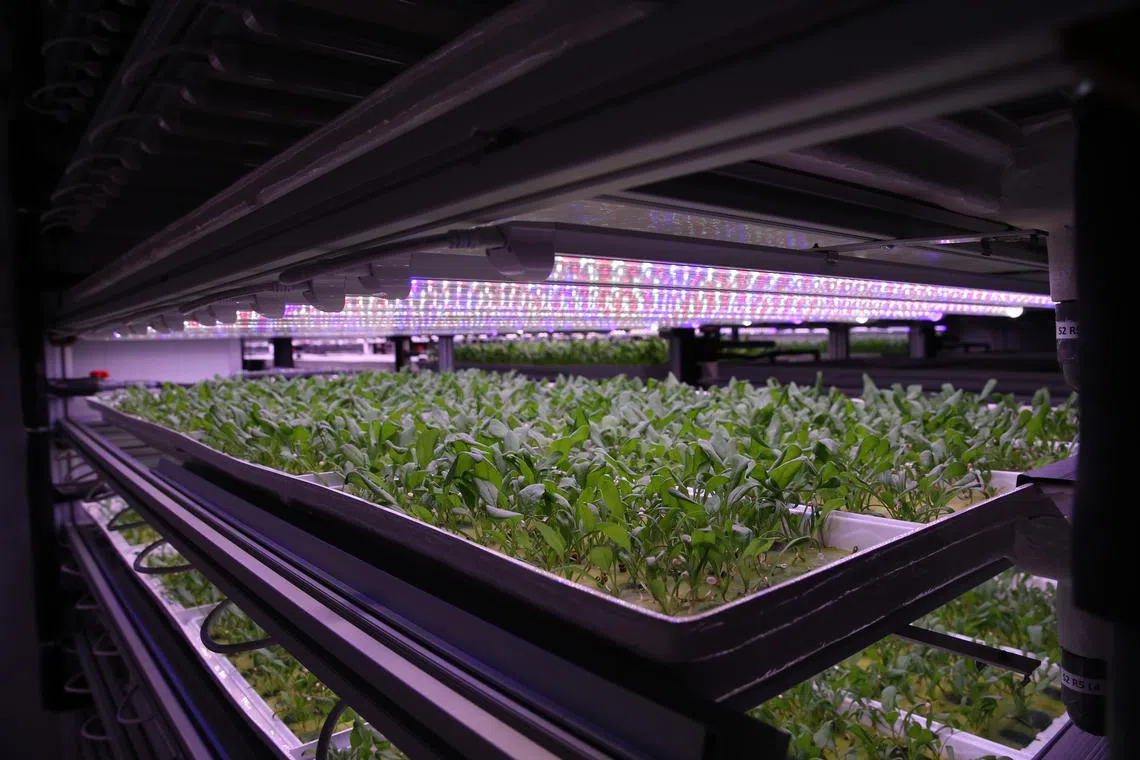Artisan Green’s new farm in Sungei Tengah will have farm-to-table dining concept
Sign up now: Get ST's newsletters delivered to your inbox

Artist's impression for Artisan Green's new open-concept farm in Sungei Tengah, which will be ready in 2025.
ILLUSTRATION: ARTISAN GREEN
Follow topic:
SINGAPORE – Artisan Green is adding a bigger, better farm to its stable come 2025.
The local vegetable farm’s new 2ha site – the size of around three football fields – in Sungei Tengah will have an indoor production area of 5,500 sq m and an outdoor production area of 1.5ha.
Its existing one in Kallang, an indoor farm, has an area of 300 sq m.
The new farm will grow its signature baby spinach, along with other leafy greens and microgreens. It will also have a farm-to-table dining concept to educate consumers on the value of buying locally grown produce, said chief executive Ray Poh.
The company is one of the few budding shoots of success in a sector grappling with teething challenges from high electricity costs to lack of demand.
But the journey has not been easy, Mr Poh told The Straits Times. The company did not succeed in the previous bidding round in 2020 for an agricultural land tender meant for vegetable farming, nor was it able to lease a plot in the commercial market.
Eventually, it managed to secure a plot in Sungei Tengah in April 2024. In hindsight, it turned out to be a blessing.
With only a small-scale facility in Kallang, Mr Poh decided to focus much of his efforts on maximising output by zooming in on fundamental plant science that would help boost production, ranging from baby spinach to herbs and microgreens like dill and basil.
This involves the correct mix of nutrients, sufficient water and light, which may differ at various stages of the plant’s growth, he added. “You have to understand plant science to grow things well. Because once you scale up, the problems also increase exponentially,” he noted.
The new farm will produce 30 tonnes of vegetables a month in the initial phase, up from one tonne a month currently. In the second phase from 2026, this will be increased to 90 tonnes a month.
“We decided to do our construction in phases, which would allow us to begin operations early, and start selling our vegetables. This can help us to better recoup our costs as we go along,” Mr Poh said.
The farm’s indoor section will feature a controlled environment, tapping LED lights, for instance, to grow higher-value crops like baby spinach and microgreens. Its outdoor greenhouse component would be more suitable for common local crops like xiao bai cai.
The farm-to-table restaurant, which will serve dishes using the vegetables harvested from the farm, will also be operational by 2025.
The total construction cost would be around $14 million.
Currently, Artisan Green’s vegetables are sold in supermarkets like Little Farms, FairPrice and Cold Storage, but it has come to a point where demand is beginning to outstrip supply.
Mr Poh has tried to boost production as much as possible by innovating and testing new crop “recipes”.
This involves constantly tweaking and optimising the usage of nutrients, for example, to keep costs in check and maximise yields.

Spinach being grown at Artisan Green, a local hydroponics urban indoor farm in Kallang Place.
PHOTO: ST FILE
Using a digitalised platform that consolidates the various crop recipes that have been developed over the years – similar to a central kitchen at McDonald’s – Mr Poh has been able to automate the entire growing process.
Apart from helping to alleviate labour costs, the platform can be rolled out at any new facility, no matter the size, which makes scaling up easier.
Even though he has had more time to work through the teething challenges of setting up a farm, Mr Poh is not taking any chances.
To ease into the scale-up process, he has set up plant operations in Vidacity temporarily as a “dry run” to work out any kinks that might surface along the way. Vidacity, in Pasir Ris, is a sustainability innovation hub that brings together a range of start-ups.
“Hopefully, this can prove that farming high-tech in Singapore is still possible, despite the challenges and difficult operating conditions here,” he said.
Mr Poh hopes that to make things easier for prospective farmers, more can be done to streamline the process of applying for a farm licence and constructing the facility.
For example, farmers have to liaise with more than 10 agencies, from the Building and Construction Authority to ensure the constructed site is safe, to the National Environment Agency for pollution control, to the Singapore Civil Defence Force to comply with fire safety regulations.
Farmers also need to engage a reputable consultant or architect – known within the industry as “Qualified Person” – to draw up a design and construction plan for the farm, or risk facing further delays along the way, Mr Poh added.


